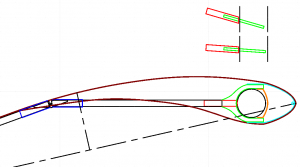I don’t have that much time to spend on a blog post right now but figured I’d give a quick not-too-detailed update of what’s going on with Tua-Tua. She’s getting a wingsail, and her inboard diesel is in the process of being replaced with an electric outboard motor, and her cockpit is being mostly removed.
This wingsail design, quite similar to what I was planning back in 2015, although this time not out of wood, incorporates the same hinges as the previous rig. In red are plugs made of solid UHMWPE rod. Green is 15 mm UHMWPE sheet sawed into an U jaw shape. Luff formers (light blue) are bent out of aluminium with a ring bolt for downhauls. There will be 2 or 3 luff formers sewn into the sail in between the battens. Orange line is a batten parrel in the form of webbing, keeping the batten from moving aft. The basic principle is similar to a gaff rig. The weight of the rig will keep the jaws in place. I have slight concerns about friction and possible wear on the mast from the jaws but we’ll see. Those issues can be addressed next winter. The sail is in burgundy red (as is the sailcloth I’ve purchased, Swela Outguard 190). It is doubled over the forward batten and single/flat over the rear one.
First prototype nose piece has the luff former attached with 20 mm M6 bolts with threads tapped into the 15 mm sheet. I might change this to self-tapping wood screws but haven’t decided. The next piece in the assembly is the plug.
This didn’t turn out completely as I had hoped so have ordered a router bit that will simplify the process significantly. Meanwhile I will finish the first batten crudely to confirm that it works as intended and feels solid enough.
Edit May 23rd: While in the process of removing the mounts for the double backstays today I realized that they would be perfect for mounting the outboard on (and a lot cheaper than having to buy or build new ones from scratch). So I will figure out how to attach a wooden bracket to them, then I can put the outboard on either side depending on the conditions/circumstances.
Stinkbox is going out. Replacing it with an outboard electric motor. You can read about my initial musings here. At the time I was toying with inboard electric or outboard gasoline, but it never really struck me that an electric outboard would be the sweet spot. Getting space below the cockpit for double berth, freeing up the forepeak for any kind of rig I would want to build, and doesn’t have the issues where the motor comes out of the water in a swell and heats up the impeller so the engine effectively (albeit temporarily) dies.
Energy requirements will be satisfied by 4x 100W solar panels feeding a 24V 190 Ah LiFePO4 battery bank (4.5 kWh). Range will be up to 40-50 nm in calm conditions, ghosting along at 2 knots. Enough to get you out of the doldrums or busy shipping lanes when the wind has died out. And will be sufficient for harbour maneuvering where necessary. It will not be enough to get off a lee shore in a gale without the help of sails and it will not help in fighting against a 5 knot current – those will need to be tackled like in the good ol’ days with basic seamanship, good planning and patience.
As mentioned in multiple past blog posts I’m not a huge fan of large cockpits. They become dangerous when filled with water, even with dual 2″ drains, and the space wasted below is simply not worth it. A small footwell will be left, enough for a helmsman (or woman) sitting relatively sheltered and comfortably at the tiller. The rest of the cockpit (from old mainsheet track to companionway) will be flush decked, giving you the option to sit on the cockpit coamings, or when heeled over just sit like normal people ignoring the footwell.
Everything needed for all of the above has already been purchased. This is locked down. The only enemy here is the ticking clock, as we’re hoping to be able to sail south before North Atlantic autumn conditions get too rough (especially around the Bay of Biscay starting October).
Questions? Send a comment. 🙂
